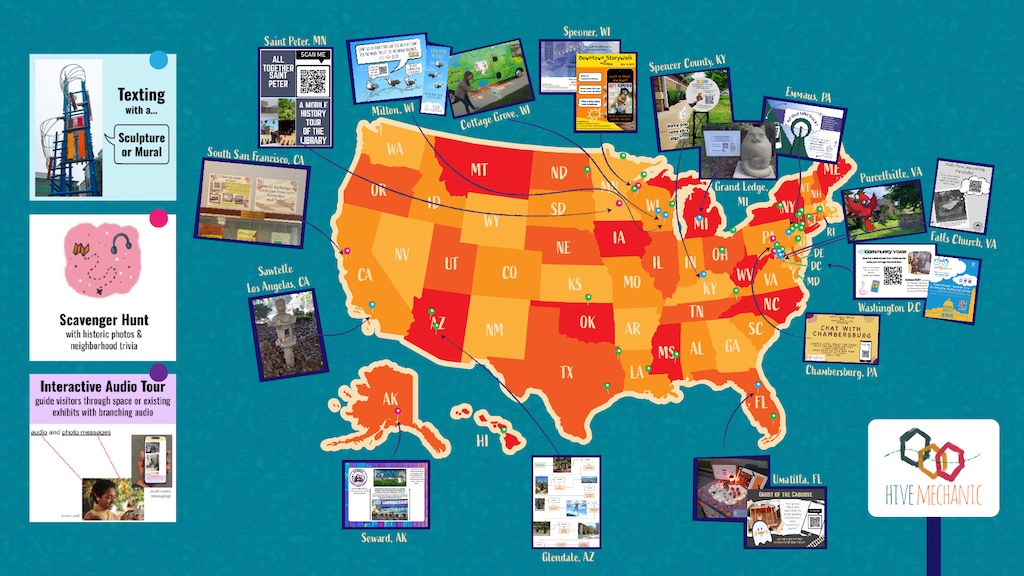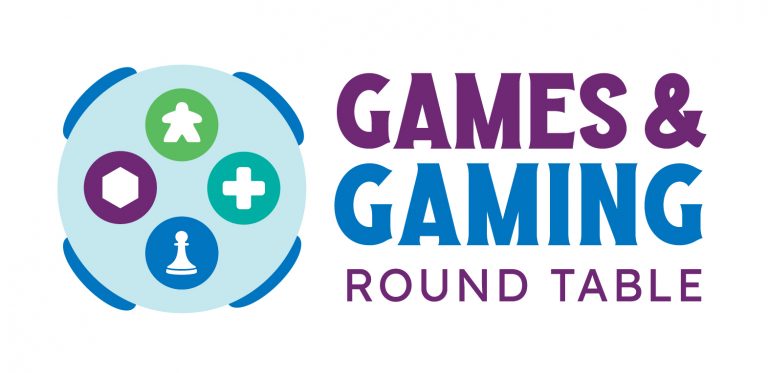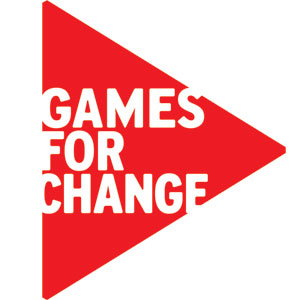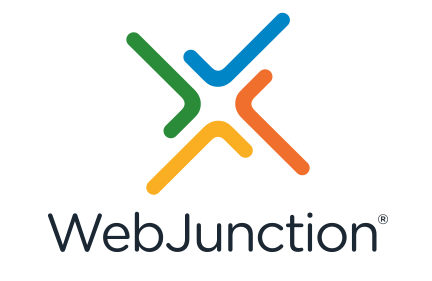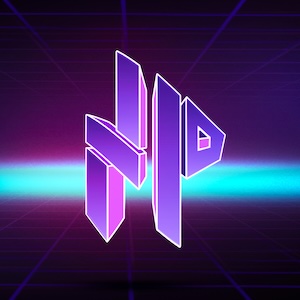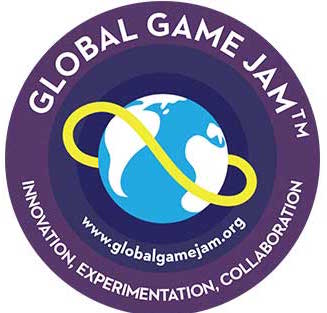
In more than 50 cities and towns, library and museum staff are “engaging beyond our walls” (EBOW) to make their own local games, interactive stories and outdoor experiences. Their playful creations are resulting in stronger places, reaching new audiences, and co-creating a sense of place. Our mission is to provide the tools, research, and low-tech “recipes” so that any town can make their own. Funding and collaborators include the Smithsonian, IMLS (the Institute of Museum and Library Services), the DC Public Library, DC City Government, the Humanities Truck, AU Game Center and more.
A. What it looks like: See what they made.
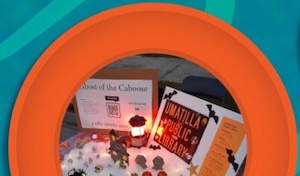
For a sample flavor, see our experience teaser (12-min video on YouTube, or 1-hour librarian webinar recording). Our tasting menu of featured projects is a sample of what local library and museum staff have made, each with more detailed photos and documentation. Explore new forms that are emerging at the intersection of physical, digital, and networked society. Our philosophy and design values are detailed below. Read about site visits and presentations in our blog posts in the EBOW category.
B. How to make your own.
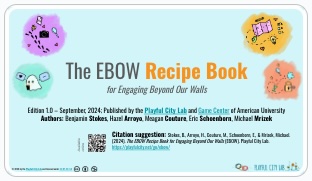
Try our recipe book for 15+ models of what works, and bring one to your community. Stretch your imagination! Each builds on a foundation of tools and design tactics that are chosen for outdoor play and neighborhood impact. Many of our core design tactics, from QR codes to narratives with an interactive host, are described in the recipe book. For a step-by-step learner guide, our first pass was created with WebJunction especially for librarians, but will work for many others. NEW TOOLS: We created or piloted nearly all these creations with our custom game engine and authoring system called Hive Mechanic. In terms of books, we’re starting starting a DIY reading list. Give your project a locally played sticker.
C. Learner guides, workshops, and curriculum.
Repurpose our curricula for your own workshops — including for neighbors, partners, and university design programs. We believe this movement will scale as a series of practices and local adaptations, rather than as a software product or single design.
D. Why bother: Impact types, research, and policy.
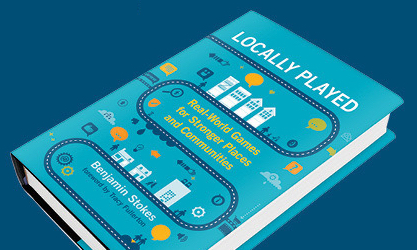
Browse the impact types we see for this kind of design. Explore our findings on democratizing design at the local level, including barriers and opportunities. This research extends our pioneering book, Locally Played: Real-World Games for Stronger Places and Communities.
- Repositioning the library as a community catalyst – with implications for fundraising, capacity building, new partnerships, and making a strong place
- Community engagement and partnerships. Some of the most transformative connections came through making the activity and involving local partners.
- Placemaking / place-keeping and sense of place.
- Reaching new audiences.
- Expanding the imagination of what is possible, how places can be connected, etc.
- Turning librarians into “designers.”
- Building demand (democratizing the playing of games)
D. Meet, join, network – including at events.
Connect to the movement for local games and engaging beyond our walls, including for news, ideas, collaborators, funding, and more. Some starting points:
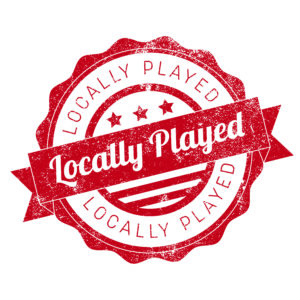
- Playful City Lab: Get notified when we release new research or tools. See our list of upcoming events and archives.
- Libraries can plug into ALA’s Games and Gaming Roundtable (GameRT), dedicated to “creating an awareness of the value of gaming and play in libraries, schools, and related learning communities”
- Libraries can also see our overview on WebJunction on local games and interactive stories, and our webinar (a project of OCLC)
- Games for Change (G4C), the leading festival and hub for serious games, games tied to social issues, and to some extent educational games and XR. Note that the organization was co-founded by our own Benjamin Stokes.
- No Proscenium: Immersive media coverage and conversation, from theater to local games – often listed by city. Great podcast. Many of the projects covered are fancy creations by artists and technical wizards, but they are friendly to efforts to democratize the movement and provide more universal access too. See also ARGNet’s overview of alternate reality games, and get inspired by their email lists and coverage of emerging projects.
- Global Game Jam: taking place over 48 hours each year in cities and towns worldwide (108 countries with 100,000 makers), this gathering is a chance to find fellow creators and convince them to make something for engaging beyond our walls.
- Come Out and Play: a rotating festival activating city space with emerging forms of play
- Who else? Send us your ideas for hubs and organizations!
Philosophy and Design Values

These are games and activities that can typically be played with ordinary cell phones, paper-meets-digital hybrids, or with a “storytelling box” kiosk from your local makerspace. Our dream is to diversify participation in local storytelling by supporting rural and small libraries and museums, and by centering local voices in all game and story content. We use text and multimedia messaging, which do not require data plans or wifi. (Text and multimedia messaging are increasingly unlimited for most phones, and are separate from data plans to access the internet.) Low-tech is an unusual approach for game design, but one that is essential for increasing access and meeting the equity goals of public libraries. The story games in this project can be created and played for free, without any programming skills – and still provide an optional starting point for those seeking a STE(A)M trajectory.
The need to meet the public beyond our walls is growing rapidly. Gentrification and neighborhood change redoubles the need to know our local history – and hear local voices. The demand to give voice to community history and local culture has never been higher – including in public space.
With this project, civic institutions like libraries and museums have leveraged their core strengths in media literacy and their roles as local information brokers, increased access to game design, and helped to bridge the gap between the history in local archives and interactive media.
This project addresses three immediate needs currently lacking in public libraries and museums: (1) basic training and curricula in game design for communities; (2) access to templates of successful community games to simplify design, and greatly reduce barriers to scale; and (3) free authoring tools like our Hive Mechanic that are easy enough for non-technical users to create games. Budgets today are tighter than ever, and digital divides are growing.
Timeline and Participants
Our insights come from training library and museum staff in 50+ cities. This map gives a visual overview:
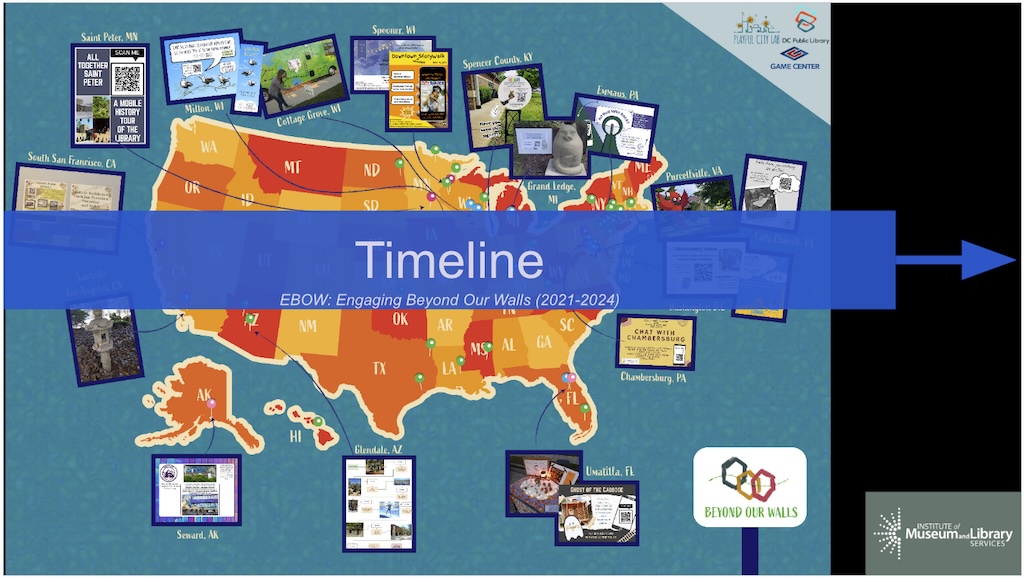
For our deep dive with libraries (2021-24), three cohorts participated:
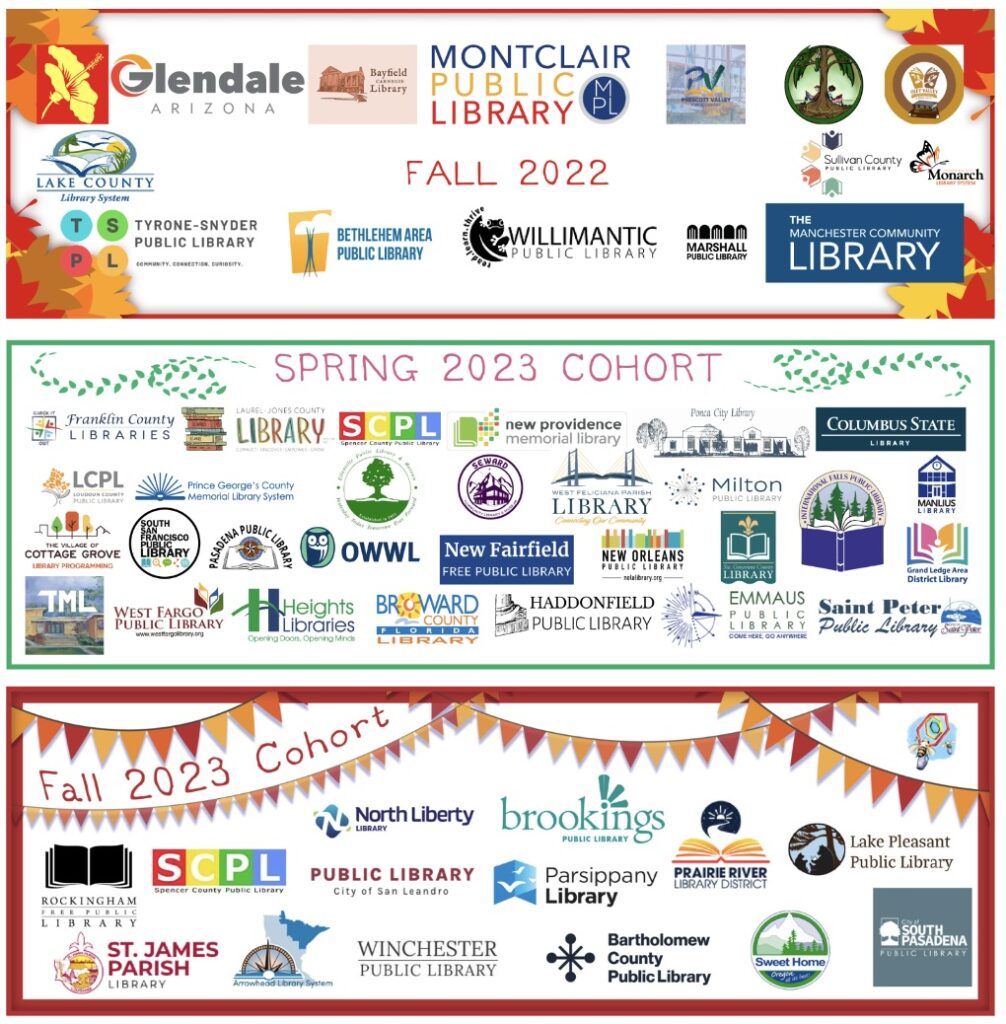
By date:
• 2014: Sankofa Says was our first experimental game with telephony, in which players meet neighbors and discover local history in growing crowds. It was an official selection of the IndieCade Festival of independent games. Teams competed to draw a crowd at local monuments, answering trivia questions and acting out city myths. Playing involves a rebuilt payphone, paper maps, the city historian and cellphone photography. For more, see the game website from our design collective, the Leimert Phone Company.
• 2018: Concept demonstrations with key partners in Washington, DC. These were working prototypes, but with intensive coding and 3rd-party tools
• 2019: Software development of Hive Mechanic begins by Audacious Software. Two technical versions tested; one was selected for our beta.
• Feb 1, 2020: Workshop at the AU Global Game Jam — the first with Hive Mechanic
• Spring 2020: Release of the open-source code for “Hive Mechanic 1.0“ on GitHub
• September 2020: Launch of “Buoyant Oracle” and “Mural, Mural on the Wall” installations for broad public use, among other working projects
• 2021: Launch of “Hard Choices” activity with DC Office of Planning, for crowds and live polling on the future of a neighborhood
• 2021: Significant grant ($249k) from IMLS – see press release and LG-250108-OLS-21
- Regional pilot (spring 2022)
- National cohort #1 (fall 2022): Zoom pilot
- National cohort #2 (spring 2023): Zoom (open entry)
- National cohort #3 (fall 2023-2024): Asynchronous course of six weeks
• 2024: Reports released on the initial “EBOW recipes,” tasting menu of projects
• Fall 2024: Release of “Version 2.0” of the open-source code for Hive Mechanic (coming soon)
Partners and Funding
Primary funding comes from IMLS (the federal Institute of Museum and Library Services), which is the leading agency funding libraries and museums in the United States (see #LG-250108-OLS-21). Early prototypes were developed with or funded by the Smithsonian Anacostia Community Museum, the Smithsonian Women’s Committee, and the DC City Government. Seed funding for Hive Mechanic came from American University; software development by Audacious Software.
